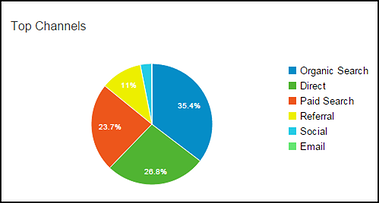When we ask our prospects to tell us the number one thing that frustrates them about their digital ad campaigns, they usually say how unpredictable their return on investment is. They never know if their campaigns are going to be successes or duds that do little more than waste their time and money. Then we ask them which metrics they’re using to track their campaigns and they sheepishly look around the room and finally admit they’re not using metrics to track their campaigns. And then we watch as the light bulb goes off above their heads.
Online marketing doesn’t have to be a crap shoot. Here are seven metrics you can and should be using to measure the success of your digital ad campaigns.
1. Point of Origin Traffic
Sometimes “total visits” don’t give you an indication of which channels are performing well and which aren’t. Located in the “Acquisition” section of your Google Analytics dashboard, this metric will give you an overview of the four main channels you need to pay attention to: direct traffic (direct visits to your site), referral traffic (from external links on other sites), organic traffic (traffic coming from search), and social traffic (those visitors who found your site through social media pages).
2. Cost Per Lead
This is a very specific metric because it is dependent on the strategies you use for each channel. To determine your cost per lead you’ll want to consider the average monthly cost of your campaign and compare it to the total number of leads each channel generated for you. For instance, if you spent a total of $300 on a pay-per-click campaign and it generated 10 leads for you, each lead cost you $30.
3. Overall Traffic
Your overall traffic, or “total traffic,” is a metric that will give you a broader, bird’s eye view of your campaign. The main target for your traffic should be your primary website, but you can also measure total visits to any of your digital assets such as specific landing pages. Pay attention to this number, and if you see it drop over time, you’ll want to figure out which channel is damaged and stop the bleeding. A healthy campaign should see a slow and steady increase of traffic over time.
 4. Bounce Rate
4. Bounce Rate
It sounds like a fun metric, who doesn’t love bouncing? But you want your bounce rate to be low because a low rate means visitors who land on your website stick around, they don’t “bounce” on up out of there. You want visitors to spend as much time as possible on your site because the longer they stay and explore, the more likely they are to convert.
5. Total Conversions
This is perhaps the most important metric for measuring your campaign’s success because it will show you the profitability of your overall marketing efforts. There are a variety of possible conversions: you could have someone fill out a form, subscribe to your newsletter or complete a checkout. A conversion is simply any action you want your visitors to take. If your conversion rate is low, you’ll want to take a look at a variety of factors such as messaging, website design, and poor offers.
6. New Sessions
Another metric found in your Google Analytics dashboard, this measurement tells you how many site visitors are new and how many are recurring. Pay attention to this one because you want a website that is “sticky” enough to get repeat visits. This is especially significant when you see a drop in recurring visits after you change the design or copy on your website.
7. Projected ROI
Ah, the Holy Grail metric of any marketing campaign, your ROI reflects your campaign’s profitability. Go through all your digital channels and calculate your ROI for each one, then compare these numbers and make budgeting choices accordingly. The channels that aren’t performing for you don’t deserve your budget. It’s better to give that money to the channels that are boosting ROI.
If you take the time to regularly check these metrics you’ll maintain a steady sense of the health of your digital ad campaigns. This will help you to refine your strategies and tactics over time which will, in turn, help you generate more leads and revenue.
RELATED POSTS:




